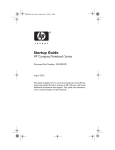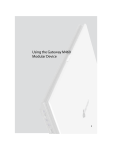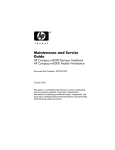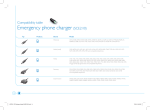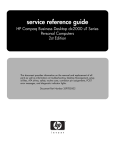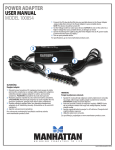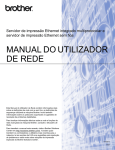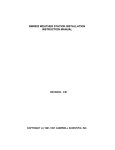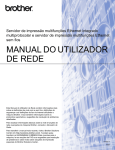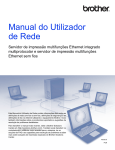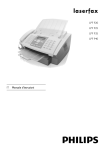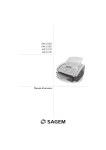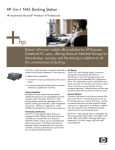Download HP 333953-001 User's Manual
Transcript
333953-001.book Page 1 Monday, July 14, 2003 2:40 PM Startup Guide HP Compaq Notebook Series Document Part Number: 333953-001 August 2003 This guide explains how to set up your hardware and software, locate and install the latest versions of HP software, and locate additional information and support. This guide also introduces you to exterior features of the notebook. 333953-001.book Page 3 Monday, July 14, 2003 2:40 PM © 2003 Hewlett-Packard Development Company, L.P. Microsoft and Windows are trademarks of Microsoft Corporation in the U.S. and/or other countries. SD Logo is a trademark. The information contained herein is subject to change without notice. The only warranties for HP products and services are set forth in the express warranty statements accompanying such products and services. Nothing herein should be construed as constituting an additional warranty. HP shall not be liable for technical or editorial errors or omissions contained herein. Startup Guide HP Compaq Notebook Series Reference Number: nc8000/nw8000 First Edition August 2003 Document Part Number: 333953-001 333953-001.book Page iii Monday, July 14, 2003 2:40 PM Contents 1 Hardware and Software Setup Setting Up the Hardware . . . . . . . . . . . . . . . . . . . . . . . . . 1–1 Setting Up the Software . . . . . . . . . . . . . . . . . . . . . . . . . . 1–5 Installing Optional Software . . . . . . . . . . . . . . . . . . . 1–6 Selecting Regional Settings . . . . . . . . . . . . . . . . . . . . 1–7 Selecting Screen Settings. . . . . . . . . . . . . . . . . . . . . . 1–8 Setting Up Wireless LAN . . . . . . . . . . . . . . . . . . . . . 1–8 Setting Up Bluetooth . . . . . . . . . . . . . . . . . . . . . . . . 1–10 Safeguarding the Notebook . . . . . . . . . . . . . . . . . . . . . . 1–11 Protecting the Notebook Against Viruses . . . . . . . . 1–11 Turning Off the Notebook . . . . . . . . . . . . . . . . . . . . 1–11 Using the Notebook Safely . . . . . . . . . . . . . . . . . . . . . . 1–11 Regulatory and Safety Information . . . . . . . . . . . . . . . . 1–12 2 Additional Information, Help, and Updates Using the Documentation Library CD . . . . . . . . . . . . . . . Getting Help . . . . . . . . . . . . . . . . . . . . . . . . . . . . . . . . . . . Using the Help and Support Center in Windows XP . . . . . . . . . . . . . . . . . . . . . . . . . . . . . . . Contacting Technical Support . . . . . . . . . . . . . . . . . . Installing a Retail Version of an Operating System. . . . . Startup Guide 2–1 2–3 2–3 2–4 2–6 iii 333953-001.book Page iv Monday, July 14, 2003 2:40 PM Contents 3 Notebook Features Pointing Device Components. . . . . . . . . . . . . . . . . . . . . . 3–1 Top Components . . . . . . . . . . . . . . . . . . . . . . . . . . . . . . . 3–2 Lights . . . . . . . . . . . . . . . . . . . . . . . . . . . . . . . . . . . . . . . . 3–5 Left Side Components . . . . . . . . . . . . . . . . . . . . . . . . . . . 3–7 Right Side Components . . . . . . . . . . . . . . . . . . . . . . . . . . 3–9 Front View Components . . . . . . . . . . . . . . . . . . . . . . . . 3–11 Rear Panel Components . . . . . . . . . . . . . . . . . . . . . . . . . 3–12 Bottom Components. . . . . . . . . . . . . . . . . . . . . . . . . . . . 3–14 Labels . . . . . . . . . . . . . . . . . . . . . . . . . . . . . . . . . . . . . . . 3–16 Index iv Startup Guide 333953-001.book Page 1 Monday, July 14, 2003 2:40 PM 1 Hardware and Software Setup Å WARNING: This notebook is designed to run demanding applications at full power. As a result of increased power consumption, it is normal for the notebook to feel warm or hot when used continuously. To avoid potential discomfort or burns, do not block the air vents or use the notebook on your lap for extended periods. The notebook complies with the user-accessible surface temperature limits defined by the International Standard for Safety of Information Technology Equipment (IEC 60950). of limitations in current TFT manufacturing technology, ✎ Because TFT displays may show imperfections as bright, dim, or dark spots. HP does not guarantee that TFT displays are free from such imperfections. governmental agency and safety information, refer on the ✎ For Documentation Library CD to the Regulatory and Safety Notices. Setting Up the Hardware Ä CAUTION: To ensure that the correct drivers load and to prevent file corruption or damage to the components during initial setup: ■ ■ ■ Startup Guide Do not set up the notebook while it is docked in an optional Port Replicator. Do not remove the battery pack until the notebook has been connected to external AC power. Run the notebook on external AC power, not on battery power, throughout initial setup. 1–1 333953-001.book Page 2 Monday, July 14, 2003 2:40 PM Hardware and Software Setup To set up the notebook: 1. Slide the primary battery pack into the battery bay until it is seated. you will not be using the notebook for 2 weeks or more, ✎ Ifremoving the battery and storing it will prolong its life. For more information, refer on the Documentation Library CD to the Hardware Guide, “Battery Packs” chapter. 1–2 Startup Guide 333953-001.book Page 3 Monday, July 14, 2003 2:40 PM Hardware and Software Setup 2. Connect the notebook to external AC power: a. Place the notebook on a flat surface near an electrical outlet. b. Connect the AC adapter cable 1 to the power connector on the notebook. c. Connect the power cord 2 to the AC adapter. d. Plug the power cord 3 into an electrical outlet. (Power cords and outlets vary by country.) Startup Guide 1–3 333953-001.book Page 4 Monday, July 14, 2003 2:40 PM Hardware and Software Setup 3. Open the notebook by pressing the display release latch 1 and lifting the display 2. 4. Turn on the notebook by pressing the power button. 1–4 Startup Guide 333953-001.book Page 5 Monday, July 14, 2003 2:40 PM Hardware and Software Setup After the notebook powers on: ■ The power/standby light turns on. (See “Lights” later in this guide for more information.) ■ The battery pack in the battery bay begins to charge, and the battery light turns on. (The battery light remains on while the battery pack is charging and turns off after the battery pack is fully charged. See “Lights” later in this guide for more information.) ■ The software setup prompt displays on the screen. Setting Up the Software A prompt to set up your software displays on the screen when the notebook is turned on for the first time. Before responding to the prompt and proceeding through the onscreen instructions, read the following caution and other installation information contained in this chapter. Ä CAUTION: To prevent file corruption and to ensure that the correct device drivers install, follow these guidelines during software setup: ■ ■ ■ Do not unplug the notebook from the electrical outlet. Do not shut down the notebook. Do not remove or insert a drive. ■ After you begin the software setup, you must complete the entire process without interruption. Setup time varies. ■ If you are prompted to select a language, choose carefully. The languages you do not choose are deleted from the system and cannot be restored once the setup process has begun. ■ If you are prompted to accept the End User License Agreement, you must choose Accept to continue the software setup. Startup Guide 1–5 333953-001.book Page 6 Monday, July 14, 2003 2:40 PM Hardware and Software Setup ■ Preloaded software applications are included with the notebook but must be installed through the Software Setup utility. Preinstalled software applications have already been installed on the notebook and require no further installation procedures. ■ This guide does not take into account any variation that may result from the notebook being connected to a network. ■ This guide documents the Windows 2000, Windows XP Professional, and Windows XP Home operating systems. Any other operating systems installed on this notebook after purchase may not match the descriptions and procedures provided in this guide. ■ This guide documents the category view that is used by default in Windows XP. If your notebook is set to classic view, you may notice discrepancies between your notebook and this documentation. For information on switching views, see Windows XP Help and Support. Installing Optional Software You can install third-party software or preloaded utilities any time after initial setup is complete. ■ To install third-party software, refer to the documentation included with the software. ■ To install a preloaded utility: ❏ In Windows 2000, select Start > Programs > Software Setup. ❏ In Windows XP, select Start > All Programs > Software Setup. A setup wizard loads and a list of applications displays. Select the application you want to install and follow the instructions on the screen. 1–6 Startup Guide 333953-001.book Page 7 Monday, July 14, 2003 2:40 PM Hardware and Software Setup the descriptions and space requirements of preloaded ✎ ToHPview utilities without installing them: ■ In Windows 2000, select Start > Programs > Software Setup. ■ In Windows XP, select Start > All Programs > Software Setup. After viewing the utility information, select Cancel. Selecting Regional Settings Keyboard language and other regional preferences such as time, date, and currency format, are set in the operating system. To access these settings: ■ In Windows 2000, select Start > Settings > Control Panel > Date/Time, or select Start > Settings > Control Panel > Regional Options. ■ In Windows XP, select Start > Control Panel > Date, Time, Language, and Regional options > Date and Time, or select Start > Control Panel > Date, Time, Language, and Regional options > Regional and Language Options. For information about selecting regional settings, open the Regional Options window, then use context-sensitive Help. To use context-sensitive Help, select the question mark button in the upper right corner of the window, then select an item. A definition, explanation, or procedure is displayed. Startup Guide 1–7 333953-001.book Page 8 Monday, July 14, 2003 2:40 PM Hardware and Software Setup Selecting Screen Settings If you would like to see more items on your screen or to see the items on your screen displayed larger, change the screen resolution setting in your operating system. To access the screen resolution settings: ■ In Windows 2000, select Start > Settings > Control Panel > Display > Settings tab. ■ In Windows XP, select Start > Control Panel > Appearance and Themes > Display > Settings tab. Setting Up Wireless LAN Select notebooks contain wireless LAN devices. The drivers for your wireless LAN devices have been preinstalled on the notebook. The utility that supports your wireless LAN device has been preloaded but not preinstalled. Refer to the Wireless LAN Utility Installation Instructions, provided with your notebook, for help installing the utility. Using Wireless LAN Utilities in Windows 2000 Windows 2000 does not have an automatic wireless network configuration utility. The WLAN utility provided by HP on your notebook must be used for wireless connections. Refer to the Wireless LAN Utility Installation Instructions, provided with your notebook, for help installing the utility. 1–8 Startup Guide 333953-001.book Page 9 Monday, July 14, 2003 2:40 PM Hardware and Software Setup Using Wireless LAN Utilities in Windows XP An automatic wireless network configuration utility is available on notebooks with Windows XP. This utility is enabled by default. However, if your notebook is equipped with an HP-installed WLAN device, you may prefer to use the utility designed to work with it instead of using the Windows utility. For additional information about using the Windows automatic wireless network configuration utility, refer to Windows Help and Support. For information about the advantages of using HP-provided utilities, refer to the following section. For information about installing an HP-provided utility, refer to the Wireless LAN Utility Installation Instructions provided with your notebook. Understanding the Advantages of HP-Provided WLAN Utilities The HP-provided utilities have advanced capabilities that enhance the use of your wireless device. These utilities work in a more integrated fashion with your wireless device to configure and manage your wireless network. They are also compatible with Cisco standards and legacy operating systems. Disabling the Automatic Wireless Network Configuration Utility By default, the Windows automatic wireless network configuration utility will attempt to configure your wireless connection. If you do not wish to use the automatic wireless network configuration utility, you must disable it by following these steps: 1. Select Start > Control Panel > Network and Internet Connections > Network Connections. 2. Right click Wireless Network Connection, then select Properties. Startup Guide 1–9 333953-001.book Page 10 Monday, July 14, 2003 2:40 PM Hardware and Software Setup 3. On the Wireless Networks tab, clear the Use Windows to configure my wireless network settings check box. 4. Select OK. The Windows automatic wireless network configuration utility is disabled until you enable it again. For additional information about the Windows automatic wireless network configuration utility, refer to Windows Help and Support. Once the Windows utility has been disabled, refer to the Wireless LAN Utility Installation Instructions, provided with your notebook, for help installing the HP-preloaded utility for your wireless device. Setting Up Bluetooth Select notebooks contain a preinstalled Bluetooth device. The utility that operates your Bluetooth device has been preloaded but not preinstalled on the notebook. Before you can use this utility, you must install it using the following steps: ■ In Windows 2000, select Start > Programs > Software Setup, select the Bluetooth utility from the list of applications, then follow the onscreen instructions. ■ In Windows XP, select Start > All Programs > Software Setup, select the Bluetooth utility from the list of applications, then follow the onscreen instructions. For more information on configuring and using the Bluetooth device, refer on the Documentation Library—Bluetooth CD to the Bluetooth by HP Getting Started Guide and the Bluetooth User’s Guide. 1–10 Startup Guide 333953-001.book Page 11 Monday, July 14, 2003 2:40 PM Hardware and Software Setup Safeguarding the Notebook Protecting the Notebook Against Viruses When you use the notebook for email, network, or Internet access, you expose the notebook to computer viruses. Computer viruses can disable the operating system, your applications, or your utilities or cause them to function abnormally. Antivirus software can detect most viruses, destroy them, and, in most cases, repair any damage they have caused. HP strongly recommends that you install optional antivirus software before using your modem or connecting to a network. Antivirus software is available from most computer or electronics retailers. To provide protection against newly discovered viruses, antivirus softare must be installed and updated periodically. Turning Off the Notebook Whenever possible, shut down the notebook by following the appropriate Windows shutdown procedure: ■ In Windows 2000, select Start > Shut Down > Shut Down, then select the OK button. ■ In Windows XP, select Start > Turn off computer > Turn off. Using the Notebook Safely To protect the notebook from the power surges that may be caused by an unreliable power supply or an electrical storm: ■ Plug the notebook power cord into an optional, high-quality surge protector. Surge protectors are available from most computer or electronics retailers. ■ Provide surge protection for the cable that connects the modem to the telephone jack. ■ Run the notebook on battery power or shut down the notebook and disconnect the power cord. Startup Guide 1–11 333953-001.book Page 12 Monday, July 14, 2003 2:40 PM Hardware and Software Setup Regulatory and Safety Information This equipment has been tested and found to comply with the limits for a Class B digital device, pursuant to part 15 of the FCC Rules. For more information, refer on the Documentation Library CD to the Regulatory and Safety Notices. This product is in compliance with relevant European Union Directives and associated standards. For more information, refer on the Documentation Library CD to the European Union Notice contained in the Regulatory and Safety Notices guide. Å WARNING: To reduce the risk of electric shock or damage to your equipment: ■ Plug the power cord into an electrical outlet that is easily accessible at all times. ■ Disconnect power from the product by unplugging the power cord from the electrical outlet. ■ If provided with a three-conductor power cord having a three-pin attachment plug, plug the cord into a grounded (earthed) outlet. Do not disable the power cord grounding pin. The grounding pin is an important safety feature. Å WARNING: To reduce the risk of personal injury, turn down the volume control before putting on headphones. Å WARNING: To reduce the risk of serious injury, read the Safety & Comfort Guide. It describes proper workstation setup, posture, and health and work habits for computer users, and provides important electrical and mechanical safety information. This guide located on the Web at http://www.hp.com/ergo and on the hard drive or on the Documentation Library CD that is included with the product. 1–12 Startup Guide 333953-001.book Page 1 Monday, July 14, 2003 2:40 PM 2 Additional Information, Help, and Updates Using the Documentation Library CD Included with the notebook is the Documentation Library CD, which contains detailed information and instructions for using your notebook. Documents on the Documentation Library CD include: ■ Hardware Guide—contains information specific to your notebook. It includes an illustrated reference to all exterior components and steps for replacing battery packs, using keyboard features and drives, connecting external equipment, and upgrading the notebook. ■ Software Guide—describes HP software, including details about power and security features. ■ Modem and Networking guide—provides details about modem connections and equipment. ■ Modem Command Guidelines—contains modem commands and programming information. ■ Maintenance, Shipping and Travel guide—details steps for notebook maintenance and guidelines for using the notebook internationally. ■ Troubleshooting guide—includes solutions for common problems encountered by users. ■ Regulatory and Safety Notices—includes governmental agency and safety information. Startup Guide 2–1 333953-001.book Page 2 Monday, July 14, 2003 2:40 PM Additional Information, Help, and Updates ■ Safety & Comfort Guide—describes the best ways to set up a safe and comfortable work environment, including ergonomic and safety information. ■ Agere Softmodem AT Command Set—provides manufacturer’s modem commands for advanced users only. ■ Broadcom NetXtreme Ethernet Networking User Guide (for advanced users only). To view a guide: 1. Insert the Documentation Library CD into a CD drive. If Autorun is enabled, the reference library menu displays on the screen (this may take a few seconds). 2. Select the language of your choice, and then the guide you want to read from the reference library menu. 3. If prompted, accept the Adobe Acrobat Reader license agreement or install Acrobat Reader by following the instructions on the screen. 2–2 Startup Guide 333953-001.book Page 3 Monday, July 14, 2003 2:40 PM Additional Information, Help, and Updates Getting Help If you cannot solve a notebook problem by using this guide or the supplementary information on the Documentation Library CD (including the Troubleshooting guide), you may need to contact HP. Using the Help and Support Center in Windows XP Notebooks with a Windows XP operating system have a customized Help and Support Center that provides a comprehensive online resource tool that can be used for the following: ■ Troubleshooting assistance ■ Downloading the latest driver updates and product information ■ Learning more about using and maintaining your notebook With the Help and Support Center, you can get immediate assistance before contacting an HP support specialist. For example, in Help and Support you can: ■ Troubleshoot and fix common notebook problems. ■ Learn how to use the software tools for working with your favorite music, video, games, and photos (on select notebook models only). ■ Get basic and detailed information about Windows XP for customizing your notebook. ■ Set up your notebook for networking and for communicating on the Web. ■ Use administration tools to manage areas such as passwords, file backups, system restore, and user accounts. ■ Learn how to print, fax, run performance and maintenance tools, and install and configure new hardware. Startup Guide 2–3 333953-001.book Page 4 Monday, July 14, 2003 2:40 PM Additional Information, Help, and Updates ■ Protect your notebook files by using security and privacy features such as antivirus software. ■ Undo changes to your notebook with System Restore. ■ Improve the performance of your hard drive and battery pack. ■ Download the latest drivers, utilities, software updates, and product documentation for your notebook. ■ View notebook information and diagnose problems. ■ Keep your notebook up-to-date using Windows Update. ■ Find compatible hardware and software. To access the online Help and Support Center: 1. Press the fn+f1 hotkey or select Start > Help and Support. 2. Follow the onscreen directions to select the online Help and Support Center feature that you need. Contacting Technical Support If you cannot solve a problem using the online Help or the documentation provided with the notebook, you can call technical support. To obtain a list of worldwide customer support telephone numbers, use either of the following methods: 2–4 ■ In Windows 2000, select Start > Settings > Control Panel > System icon > Support Information button. ■ In Windows XP, select Start > Control Panel > Performance and Maintenance icon > System icon > Support Information button. ■ Refer to the Worldwide Telephone Numbers booklet included with the notebook to contact an HP Customer Care Center or visit the HP Web site at http://www.hp.com. Startup Guide 333953-001.book Page 5 Monday, July 14, 2003 2:40 PM Additional Information, Help, and Updates To provide the fastest possible resolution of your problem, have the notebook and the following information available when you call: ■ Notebook serial number and model description, which are provided on labels affixed to the bottom of the notebook. ■ Purchase date on your invoice. ■ Conditions under which the problem occurred. ■ Error messages that have displayed. ■ Manufacturer and model of any optional printer connected. ■ Operating system version number and registration number. View these numbers in the System Properties window of your operating system. ■ The version of the system ROM installed on the notebook. Startup Guide 2–5 333953-001.book Page 6 Monday, July 14, 2003 2:40 PM Additional Information, Help, and Updates Installing a Retail Version of an Operating System The Windows operating system provided on the notebook is enhanced by HP. These enhancements add features and provide supplementary support for devices such as drives and PC Cards. Read the following caution before installing a retail version of an operating system on your notebook. Ä 2–6 CAUTION: Replacing an HP-enhanced operating system with a retail version of an operating system will result in the loss of all enhancements. In some cases, the loss of these enhancements may result in an unresponsive system. In other cases, complete USB support may not be available. Startup Guide 333953-001.book Page 1 Monday, July 14, 2003 2:40 PM 3 Notebook Features Pointing Device Components Component Description 1 Pointing stick Moves the pointer and selects or activates items on the screen. 2 Left and right pointing stick buttons Function like the left and right buttons on an external mouse. 3 TouchPad Moves the pointer and selects or activates items on the screen. Can be set to perform other mouse functions, such as scrolling and double-clicking. 4 Left and right TouchPad buttons Function like the left and right buttons on an external mouse. Startup Guide 3–1 333953-001.book Page 2 Monday, July 14, 2003 2:40 PM Notebook Features Top Components 1 Component Description Quick Launch buttons (3) Enable you to access common functions with a single keystroke. ■ QuickLock button (left)—Disables the keyboard and pointing device and clears the display. ■ Wireless On/Off button (middle)—Enables and disables the integrated wireless device(s) on the notebook when these devices are enabled in the software utilities. ■ Presentation Mode button (right)—Alternates between presentation modes. (Continued) 3–2 Startup Guide 333953-001.book Page 3 Monday, July 14, 2003 2:40 PM Notebook Features 2 Component Description Quick Launch buttons (3) (continued) ✎ To use integrated WLAN or Bluetooth, press the Wireless On/Off button and ensure that the Wireless On/Off light is on before attempting to make a connection. If the light does not come on, verify that the device utility has been installed and enabled in the software. HP-provided utilities must be installed through Software Setup. For more information, refer in this guide to “Setting Up Wireless LAN” and “Setting Up Bluetooth” or to the Wireless LAN Utility Installation Instructions provided with your notebook. For more information, refer to “Using Quick Launch Buttons,” in Chapter 2 of the Hardware Guide on the Documentation Library CD. Power button When the notebook is: ■ Off, press and release to turn on the notebook. ■ In Standby, press and release to exit Standby. ■ In Hibernation, press and release to exit Hibernation. If the system has stopped responding and Windows shutdown procedures cannot be used, press and hold for 5 seconds to turn off the notebook. ✎ This table describes default settings. For information about changing the functions of the power button and using Standby and Hibernation, refer on the Documentation Library CD to the Software Guide, “Power” chapter. (Continued) Startup Guide 3–3 333953-001.book Page 4 Monday, July 14, 2003 2:40 PM Notebook Features 3–4 Component Description 3 fn key Executes frequently used system functions when pressed in combination with a function key or the esc key. 4 Microsoft logo key Displays the Windows Start menu. 5 Keyboard lights Indicate when certain keyboard settings have been turned on. Refer in this chapter to the “Lights” section. 6 Function keys Execute indicated system functions when pressed in combination with the fn key. Refer on the Documentation Library CD to the Hardware Guide, “Pointing Devices and Keyboard” chapter. 7 MiniPCI compartment (located beneath the keyboard) Holds an optional wireless LAN or ISDN device. Ä The FCC does not allow unauthorized MiniPCI devices to be used in this notebook. Installing an unsupported MiniPCI device can prevent your notebook from operating properly and may result in a warning message. To resume proper notebook operation, remove the unauthorized device. Contact your HP Customer Care Center if a warning message about your MiniPCI device displays in error. 8 Applications key Displays shortcut menu for items beneath the pointer. 9 Display latch recesses (2) Secure the display when the notebook is closed. Memory compartment (not shown; located under the keyboard) Contains one primary memory module slot (populated) and one expansion slot. Startup Guide 333953-001.book Page 5 Monday, July 14, 2003 2:40 PM Notebook Features Lights Component Description 1 Num lock On: Num lock is on or the embedded numeric keypad is enabled. 2 Caps lock On: Caps lock is on. 3 Scroll lock On: Scroll lock is on. 4 Wireless On/Off On: An integrated wireless device has been enabled. (Continued) Startup Guide 3–5 333953-001.book Page 6 Monday, July 14, 2003 2:40 PM Notebook Features 5 Component Description Power/standby On: Power is turned on. Blinking: Notebook is in Standby. ✎ The power/standby light also blinks when a battery pack that is the only available power source reaches a critical low-battery condition. The light turns off when the system enters Hibernation or shuts down. 6 Battery On: A battery pack is charging. Blinking: A battery pack that is the only available power source has reached a low-battery condition. When the battery reaches a critical low-battery condition, the battery light begins blinking more quickly. 7 Drive On: One of the following integrated drives is being accessed: ■ Hard drive ■ Optical drive 8 3–6 MultiBay On: A device in the MultiBay is being accessed. Startup Guide 333953-001.book Page 7 Monday, July 14, 2003 2:40 PM Notebook Features Left Side Components 1 Component Description Security cable slot Attaches an optional security cable to the notebook. Ä 2 Exhaust vent Enables airflow to cool internal components. Ä 3 Optical disc drive The purpose of security solutions is to act as a deterrent. These solutions do not prevent the product from being mishandled or stolen. To prevent overheating, do not obstruct vents. Using the notebook on a soft surface, such as a pillow, blanket, rug, or thick clothing may block airflow. Reads and records CD and DVD media. (Continued) Startup Guide 3–7 333953-001.book Page 8 Monday, July 14, 2003 2:40 PM Notebook Features 3–8 Component Description 4 Optical disc drive eject button Opens the optical disc drive when pressed. 5 Battery bay Holds the primary battery pack. Battery pack ships outside the notebook. Startup Guide 333953-001.book Page 9 Monday, July 14, 2003 2:40 PM Notebook Features Right Side Components Component Description 1 PC Card eject buttons (2) Eject an optional PC Card or Smart Card (if a Smart Card Reader is installed) from the top or bottom PC Card slot. 2 PC Card slots (2) Support optional Type I, Type II, or Type III 32-bit (CardBus) or 16-bit PC Cards. ✎ In select notebooks, one PC Card slot may be replaced with a factory-installed Smart Card Reader. 3 Secure Digital (SD) slot Accepts SD memory card. 4 Infrared port Provides wireless communication between the notebook and an optional IrDA-compliant device. (Continued) Startup Guide 3–9 333953-001.book Page 10 Monday, July 14, 2003 2:40 PM Notebook Features Component Description 5 RJ-11 jack Connects a modem cable. 6 Audio line-out jack Connects optional powered stereo speakers, headphones, headset, or television audio. 7 Microphone jack Connects an optional monaural microphone. 8 MultiBay Supports an optional MultiBay device, such as a drive or battery pack 9 Bluetooth compartment Holds a Bluetooth device. ✎ 3–10 Bluetooth is not supported in all countries. Startup Guide 333953-001.book Page 11 Monday, July 14, 2003 2:40 PM Notebook Features Front View Components Component Description 1 Speakers (2) Produce system sound. 2 Display release latch Opens the notebook. 3 Mute button Mutes the system volume. The button lights up when volume is muted. 4 Volume control buttons Increase and decrease system volume. Press the volume up button (on right) to increase sound. Press the volume down button (on left) to decrease sound. 5 Wireless antennae (2) Transmit wireless data. Å Exposure to Radio Frequency Radiation. The radiated output power of this device is below the FCC radio frequency exposure limits. Nevertheless, the device should be used in such a manner that the potential for human contact during normal operation is minimized. To avoid the possibility of exceeding the FCC radio frequency exposure limits, human proximity to the antenna should not be less than 20 cm (8 inches) during normal operation, including when the notebook display is closed. Startup Guide 3–11 333953-001.book Page 12 Monday, July 14, 2003 2:40 PM Notebook Features Rear Panel Components Component Description 1 USB connector Connects USB 1.1- and 2.0-compliant devices to the notebook using a standard USB cable. 2 Self-powered USB connector Connects USB 1.1- and 2.0-compliant devices to the notebook using a standard USB cable. Also connects an optional External MultiBay to the notebook using the External MultiBay-powered USB cable. 3 1394 connector Connects a device that requires high bandwidth, such as a digital camera or other video or audio device. 4 Power connector Connects an AC adapter or an optional Automobile Power Adapter/Charger or Aircraft Power Adapter. 5 Serial connector Connects an optional serial device. 6 Parallel connector Connects an optional parallel device, such as an external diskette drive or a printer. (Continued) 3–12 Startup Guide 333953-001.book Page 13 Monday, July 14, 2003 2:40 PM Notebook Features Component Description 7 S-Video out jack Connects an optional S-Video device, such as a television, VCR, camcorder, overhead projector, or video capture card. 8 External monitor connector Connects an optional external monitor or overhead projector. 9 RJ-45 jack Connects a network cable. : Intake vent Enables airflow to cool internal components. Ä Startup Guide To prevent overheating, do not obstruct vents. Using the notebook on a soft surface, such as a pillow, blanket, rug, or thick clothing may block airflow. 3–13 333953-001.book Page 14 Monday, July 14, 2003 2:40 PM Notebook Features Bottom Components 1 Component Description Intake Vent Provides airflow to cool internal components. Ä To prevent overheating, do not obstruct vents. Using the notebook on a soft surface, such as a pillow, blanket, rug, or thick clothing may block airflow. 2 Docking connector Connects the notebook to an optional Port Replicator or an Advanced Port Replicator. 3 Keyboard access screw Allows you to remove the keyboard in order to access system memory. 4 Battery bay release latch Releases the primary battery pack from the battery bay. 5 Business card holder Holds a standard size business card. (Continued) 3–14 Startup Guide 333953-001.book Page 15 Monday, July 14, 2003 2:40 PM Notebook Features Component Description 6 Hard drive cover latch Releases the cover on the hard drive bay. 7 Hard drive bay Holds the primary hard drive. 8 MultiBay release latch Allows removal of a MultiBay device. Startup Guide 3–15 333953-001.book Page 16 Monday, July 14, 2003 2:40 PM Notebook Features Labels 1 Label Description Bluetooth label Provides regulatory information about the Bluetooth device that is available on some notebook models. ✎ You will need this information to use the Bluetooth device while traveling internationally. Bluetooth is not supported in all countries. 2 COA (Certificate of Authenticity) label Contains your Product Key number, which will be needed to update or troubleshoot your operating system. 3 WLAN label Provides regulatory information about the wireless LAN device(s) that are available on some notebook models. ✎ You will need this information to use a WLAN device while traveling internationally. (Continued) 3–16 Startup Guide 333953-001.book Page 17 Monday, July 14, 2003 2:40 PM Notebook Features Label Description 4 Serial number label Identifies the notebook. You may need this number if you call customer support. 5 System label Provides regulatory information about the notebook. 6 Modem label Lists the countries in which the modem has been approved for use. ✎ Startup Guide You will need this information to use the modem while traveling internationally. 3–17 333953-001.book Page 1 Monday, July 14, 2003 2:40 PM Index 1394 connector 3–12 A AC adapter 1–3, 3–12 AC power 1–12 Adobe Acrobat Reader 2–2 Aircraft Power Adapter 3–12 antivirus software 1–11 applications key 3–4 AT command set 2–2 audio line-out jack 3–10 Automobile Power Adapter/Charger 3–12 Autorun 2–2 B battery pack battery light 1–5, 3–6 inserting 1–2 primary bay 3–8 bay(s) hard drive 3–15 primary battery 3–8 Bluetooth 1–10, 3–10 Broadcom NetXtreme Ethernet Networking User Guide 2–2 button(s) power 1–4, 3–3 Quick Launch 3–2, 3–3 release latch 1–4 TouchPad 3–1 volume 3–11 C caps lock light 3–5 CD, Documentation Library 2–1 commands, modem 2–1 compartments, primary memory 3–4 connector(s) 1394 3–12 DC power 1–3, 3–12 docking 3–14 external monitor 3–13 External MultiBay 3–12 parallel 3–12 serial 3–12 USB 3–12 customer support 2–3, 2–4 D DC power connector 1–3, 3–12 Startup Guide Index–1 333953-001.book Page 2 Monday, July 14, 2003 2:40 PM Index display opening 1–4 release latch 1–4 display settings 1–8 docking connector 3–14 Documentation Library CD 2–2 drive(s) MultiBay 3–10 optical disc 3–7 primary hard drive 3–15 drivers 1–1 E electric shock warning 1–12 End User License Agreement 1–5 exhaust vent 3–7 External MultiBay connector 3–12 F FCC notice 1–12 fn key 3–4 function keys 3–4 H hard drive bay 3–15 Hardware Guide 2–1 headphone jack 3–10 help, technical support 2–4 Hibernation, exiting 3–3 HP telephone numbers 2–4 I infrared port 3–9 inserting battery pack 1–2 Index–2 J jack(s) microphone 3–10 RJ-11 3–10 RJ-45 3–13 S-Video out 3–13 K key(s) application 3–4 fn 3–4 function 3–4 Microsoft logo 3–4 L languages 1–5 license, software 1–5 light(s) battery 1–5, 3–6 caps lock 3–5 num lock 3–5 Power/standby 1–5, 3–6 scroll lock 3–5 Wireless On/Off 3–5 M Maintenance, Shipping and Travel guide 2–1 manuals. See Documentation Library CD memory compartment, primary 3–4 microphone jack 3–10 Microsoft logo key 3–4 modem commands 2–1 jack 3–10 Startup Guide 333953-001.book Page 3 Monday, July 14, 2003 2:40 PM Index Modem and Networking guide 2–1 Modem Command Guidelines 2–1 MultiBay 3–10 N network jack 3–13 protecting against viruses while using 1–11 O opening the notebook 1–4 operating system, installing retail version of 2–6 optical disc drive 3–7 P parallel connector, identifying 3–12 PC Card slot 3–9 phone numbers, worldwide 2–4 port, infrared 3–9 power button 1–4, 3–3 power connector 3–12 power, AC 1–4, 1–12 Power/standby light 1–5, 3–6 powered USB 3–12 problems and solutions 2–1 Q Quick Launch buttons 3–2, 3–3 Startup Guide R regional settings 1–7 Regulatory and Safety Notices 1–12, 2–1 release latch, display 1–4 RJ-11 jack 3–10 RJ-45 jack 3–13 ROM. See system ROM S Safety & Comfort Guide 2–2 safety considerations 1–11 screen settings 1–8 scroll lock light 3–5 SD (Secure Digital) card slot 3–9 security cable slot 3–7 serial connector 3–12 slot(s) PC Card 3–9 primary memory 3–4 SD (Secure Digital) card 3–9 Smart Card Reader, embedded 3–9 software Adobe Acrobat Reader 2–2 antivirus 1–11 installing 1–6 license 1–5 setup 1–5 Software Setup utility 1–6 space requirements 1–7 Index–3 333953-001.book Page 4 Monday, July 14, 2003 2:40 PM Index Index–4 U Software Guide 2–1 Software Setup utility 1–6 speakers 3–11 Standby, exiting 3–3 S-Video out jack 3–13 system drivers 1–1 USB connectors 3–12 with power connector 3–12 user guides. See Documentation Library CD T V technical support 2–3, 2–4 telephone (RJ-11) jack 3–10 telephone numbers service and support 2–3 worldwide 2–4 TouchPad 3–1 traveling with the notebook Aircraft Power Adapter 3–12 Automobile Power Adapter/Charger 3–12 Troubleshooting guide 2–1 turning the notebook on/off 1–4 vent(s) exhaust 3–7 intake 3–13 VGA display connector 3–13 volume buttons 3–11 W Windows applications key 3–4 Windows automatic wireless network configuration, disabling 1–9 wireless 802.11 wireless LAN 1–8 Bluetooth 1–10 locating device information 1–10 On/Off light 3–2, 3–3 reference guides 1–10 worldwide telephone numbers 2–4 Startup Guide











































